Active warning signs have a variable electronic display component, which becomes active when the activity or hazard described by the sign is likely to be occurring on or close to the roadway. These types of signs can be used to:
General guidance on their use is included in TCD manual Part 1 - Section 6. For the purpose of this manual, active warning signs in relation to section of roads between intersections have been included and are summarised below.
Traffic control devices manual - Part 1
Generally, the procedure described in TCD manual Part 1 - Section 6.2 (see link above) should be followed in deciding whether an active warning sign is appropriate at a particular site.
For selection criteria for school zones, refer to selecting sites and appropriate traffic control devices.
Selecting sites and appropriate traffic control devices
A number of types of active warning signs have been approved for use. These are:
Detailed information on the use of active and LED warning signs for use on state highways is included in the Specification P32: electronic warning signs on state highways and toolbox items in the High risk guide.
Approved active flashing light and Full LED signs are shown in Table 10‑1. For installation specifications refer to Appendix C.
Appendix C: Technical and installation information on active signs
Detectors may be installed in appropriate places to activate these signs. Alternatively, the signs could be manually activated locally by a person approved by the RCA and operate for a defined period which would allow the pedestrian, cyclist, horse rider or truck to get clear of the hazardous site. A variety of active and passive detector systems are available to suit the ability of different types of road users to active the detectors (eg cycle inductive loops, push button activated signs).
General warning using variable text (such as HIDDEN QUEUE) are shown in Table 10‑1. This sign should only be installed where the RCA considers that the standard warning symbols (cow, sheep, curve warning, pedestrian, cyclist, horse rider or truck) are not adequate to convey the nature and details of the hazard.
If the hazard is intermittent queues of vehicles, then detector loops or other suitable devices for detecting queued vehicles should be installed in appropriate positions in advance of the sign in order to activate the ‘HIDDEN QUEUE’ sign.
For further information see:
Active warning signs can be used in either temporary or permanent situations as follows:
Use where there is construction, maintenance or special events activities on or close to a road. Traffic safety should be provided by means of an RCA-approved traffic management plan (refer to the Code of Practice for Temporary Traffic Management (CoPTTM), which is TCD manual Part 8).
Active warning signs should only be used where the RCA:
The traffic management plan should limit the use of active warning signs to sites and traffic conditions where they are actually needed, generally in line with the principles that apply to permanent active warning signs.
An active warning sign could be provided where:
The RCA may approve a device to be mounted in the sign or located close to it to measure the presence and /or speed of approaching vehicles so that the sign only becomes active when an approaching vehicle is detected and / or if an approaching vehicle’s speed exceeds a pre-set value.
Further information on this is provided in Specification P32: electronic warning signs on state highways.
Table 10‑1: Symbolic warning active LED warning signs
| Sign code | Example | Description/use |
|---|---|---|
| W19-1.1 General warning variable | 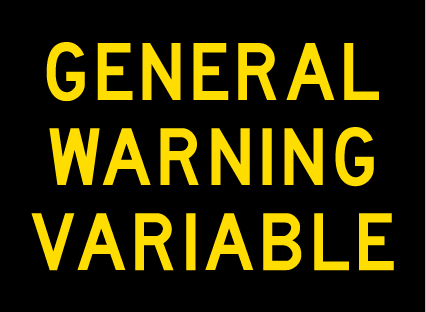 |
If possible, the message should be conveyed on one screen of text, particularly where the speed of approaching vehicles exceeds 50km/h. There should be no more than three lines of text and no more than two screens of text. If the speed limit exceeds 50km/h and the message is a long one, then two variable message signs, one positioned after the other, may be needed. If two alternating screens on one sign are used to convey the complete message, then a driver should be able to read through three screens of text before he or she passes the sign (so they can be sure that the complete message has been received). In this case, the text must alternate between the two screens and not scroll between them. See also Waka Kotahi VMS Operating Policy and P32 Specification for Electronic warning signs for sign size, fonts and spacings. For sign location, see note 6. |
| W19-2.1 (0) Symbolic warning – active LED (General) | 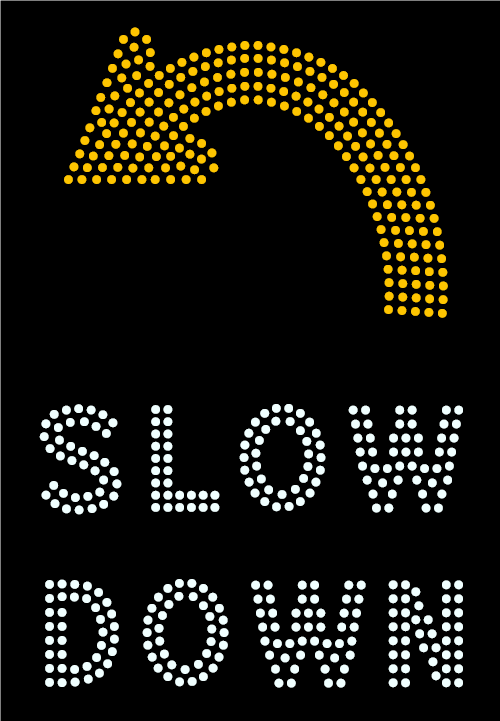 |
The W19-2.1 (0) sign consists of a yellow illuminated accepted symbol (refer note 4) with no flashing lights in the corners of the sign. These signs may also include text. These signs may be used where the RCA considers that it may be necessary to warn approaching drivers of an upcoming hazard. The image shown is an example of one of the accepted symbols, refer to note 4 for all the accepted symbols that can be used on the W19-2.1 (0) sign. For sign location, see notes 1, 2 and 3. |
| W19-2.1 (0) Symbolic warning – active LED (Curve) | 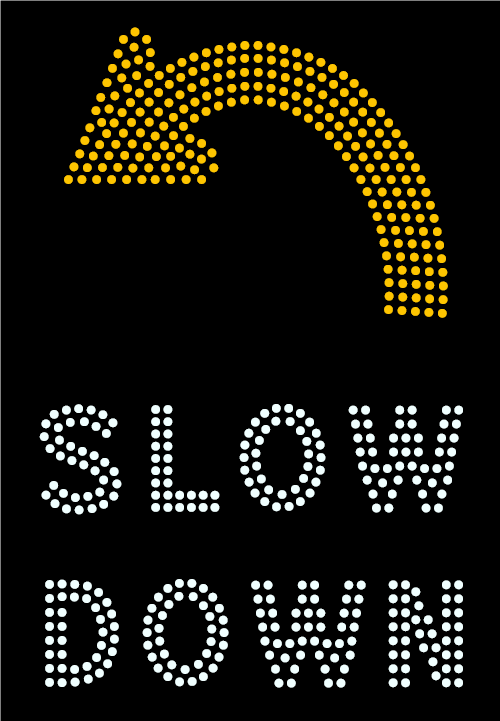 |
‘Curve with arrow head’ symbol and ‘SLOW DOWN’ or ‘advisory speed in km/h’ in advance of significant curves where drivers are likely to need to adjust their speed to negotiate safely. This active sign could connect to a device for detecting the speed of an approaching vehicle. If the advisory speed is also indicated on chevron sight boards installed on the outside of the curve, then the advisory speed figure on the sign can change to the words ‘SLOW DOWN’ if the vehicle’s speed is greater than a pre-set value. For guidance on setting the speed thresholds at which the sign is activated, refer to Section 2.1.3 in the Specification P32: electronic warning signs on state highways. The sign must include the following on the display:
If this sign is fitted with orange warning lights (making it a W19-2.1 (2)), they should only be activated when the speed of an approaching vehicle exceeds a pre-set (safe) speed. For sign location, see notes 1, 2 and 3. |
| W19-2.1 (0) Symbolic warning – active LED (Slippery Surface) | 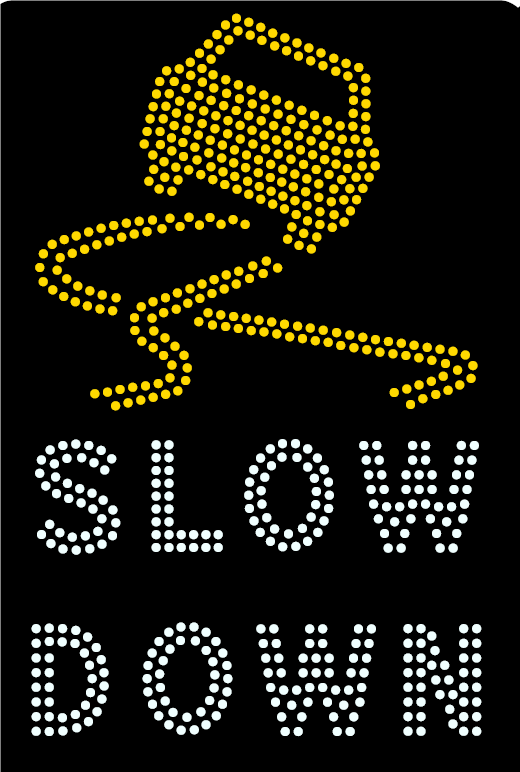 |
Car skidding symbol and either ‘ICE/GRIT’ or ‘SLOW DOWN’ in advance of locations where there is ice/grit or other road factor that may cause a driver may lose control of their vehicle. For guidance on setting the speed thresholds at which the sign is activated, refer to Section 2.1.7 in the Specification P32: electronic warning signs on state highways. Car skidding symbol - as in W14-7. For sign location, see notes 1, 2 and 3. |
| W19-2.1 (2) Symbolic warning – active LED (General) | 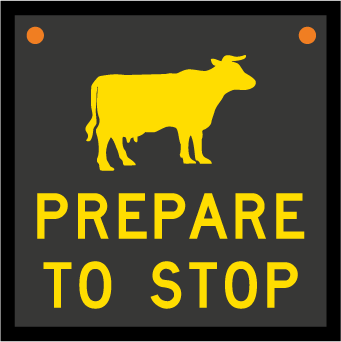 |
The W19-2.1 (2) sign consists of a yellow illuminated accepted symbol (refer note 4) with lights in the left and right hand top corners of the sign that flash alternately. These signs may also include text. These signs may be used where the RCA considers that it may be necessary to warn approaching drivers of an upcoming hazard. The image shown is an example of one of the accepted symbols, refer to note 4 for all the accepted symbols that can be used on the W19-2.1 (2) sign. For sign location, see notes 1, 2 and 3. |
| W19-2.1 (2) Symbolic warning – active LED (Livestock) | 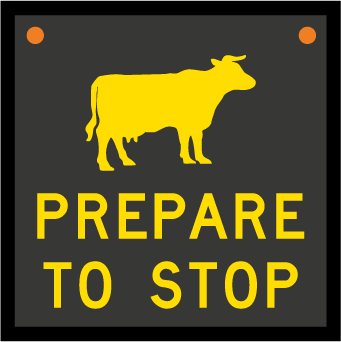 |
‘Cow’ or ‘sheep’ symbol and ‘PREPARE TO STOP’ in advance of approved Stock crossings. This sign should be activated only when livestock are crossing the roadway by either an approved livestock detecting device or by a manual switch operated by a person approved by the RCA.
|
| W19-2.1 (2) Symbolic warning – active LED (School Zone) | 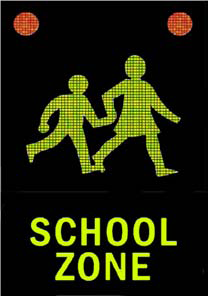 |
‘Children’ symbol (as in W16-4) and ‘SCHOOL ZONE’ in advance of locations where there is a designated school zone. For guidance on programming the activation of the sign, refer to Section 2.1.5 in the Specification P32: electronic warning signs on state highways. For sign location, see notes 1, 2 and 3. |
| W19-2.1 (2) Symbolic warning – active LED (Truck) |
Image not available at the time of publication. |
‘Truck’ symbol and ‘SLOW DOWN’ in advance of locations where there are likely to be heavy vehicles on or crossing the roadway. Truck symbol - as in A16-3. For sign location, see notes 1, 2 and 3. |
| W19-2.1 (2) Symbolic warning – active LED (Pedestrian) |
Image not available at the time of publication. |
‘Pedestrian’, ‘symbol and ‘SLOW DOWN’ in advance of locations where there are likely to be pedestrians, cyclists, equestrians or heavy vehicles on or crossing the roadway. Pedestrian symbol - as in W16-1. For sign location, see notes 1, 2 and 3. |
| W19-2.1 (2) Symbolic warning – active LED (Equestrian) |
Image not available at the time of publication. |
‘Rider on horse’ symbol and ‘SLOW DOWN’ in advance of locations where there are likely to be, equestrians on or crossing the roadway. Rider on horse symbol - as in W16-8. For sign location, see notes 1, 2 and 3. |
| W19-2.1 (4) Symbolic warning – active LED (General) | 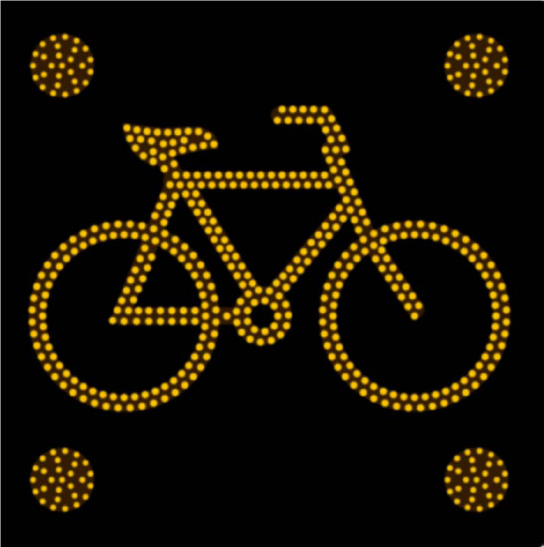 |
If there is no text displayed on the sign, the W19-2.1 (4) can also consist of a yellow illuminated accepted symbol (refer Note 4) with lights in the four corners of the sign, where the bottom two flash alternately with the top two. These signs should be used where the RCA considers that it may be necessary to warn approaching drivers of an upcoming hazard. The image shown is an example of one of the accepted symbols, refer to note 4 for all the accepted symbols that can be used on the W19-2.1 (4) sign. For sign location, see notes 1, 2 and 3. |
| W19-2.1 (4) Symbolic warning – active LED (Cyclist) |  |
‘Cyclist’ symbol in advance of locations where there are likely to be pedestrians, cyclists, equestrians or heavy vehicles on or crossing the roadway. For guidance on programming the activation of the sign, refer to Section 2.1.4 in the P32 specification. Cyclist symbol - as in W16-7. For sign location, see notes 1, 2 and 3. |
| W19-2.2 Symbolic warning – active flashing light | 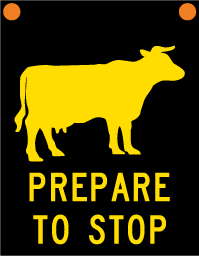 |
The W19-2.2 sign consists of a yellow reflectorised accepted symbol (refer note 5) with lights in the left and right-hand top corners that flash alternately. These signs may also include text. These signs may be used where the RCA considers that it may be necessary to warn approaching drivers of an upcoming hazard. The image shown is an example of one of the accepted symbols, refer to Note 5 for all the accepted symbols that can be used on the W19-2.2 sign. For sign location, see notes 1, 2 and 3. |
Table 10-1 notes:
| Operating speed | Distance |
|---|---|
|
50km/h |
65m |
|
70km/h |
100m |
|
80km/h |
120m |
|
90km/h |
140m |
|
100km/h |
160m |
|
Operating speed |
Distance |
|---|---|
|
50km/h |
100m |
|
60km/h |
120m |
|
70km/h |
140m |
|
80km/h |
160m |
|
90km/h |
180m |
|
100km/h |
200m |